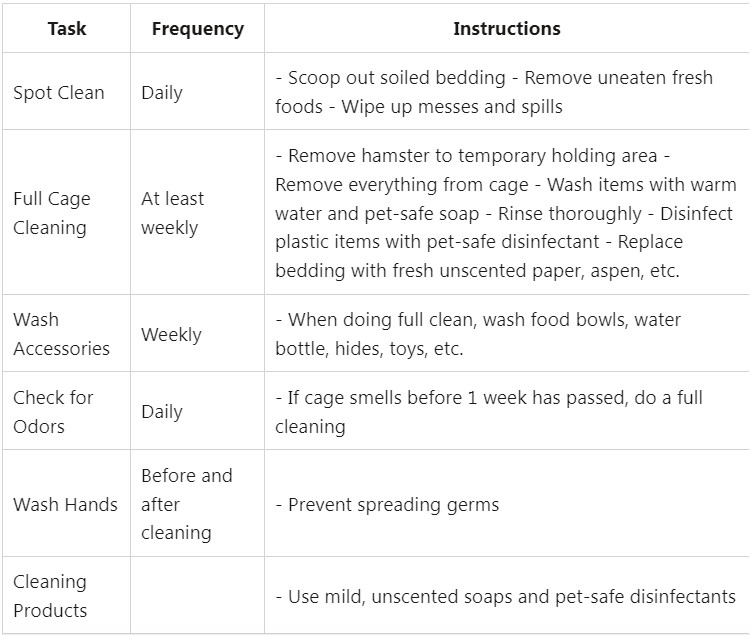Cleaning your hamster’s cage is essential for maintaining their health and well-being. A clean cage helps prevent odors, minimizes disease risk, and provides a comfortable living environment for your furry friend.
Daily spot cleaning is essential – scoop out any soiled bedding, clear uneaten fresh foods to avoid spoilage, and wipe up spills or messes. A full cage cleaning should happen at least weekly. This deep clean involves removing everything from the cage, washing all items with gentle, pet-safe soap and water, rinsing thoroughly, and adding fresh, clean bedding.
Don’t forget to wash food dishes, water bottles, hides, and toys each week too. More frequent full cleanings may be needed if you notice odors or a messy pet! Aim for full cleans at least weekly, but listen to your nose.
Avoid harsh cleaners and stick to mild, unscented soaps. Wash hands before and after cleaning. Keeping your hamster’s home clean means less smell, cleaner air, and better overall health.
With some regular work, you can keep your tiny friend happy in a fresh, sanitary space. Keep things clean, and your hammy will thrive! Here’s how you should clean a hamster cage.

#Daily Spot Cleaning
Daily or every other day, you should perform spot cleaning. Many hamsters typically designate a specific corner in their cage as a bathroom. If your hamster follows this pattern, removing the soiled bedding in that area and replacing it with fresh bedding every one or two days is advisable.
You can effortlessly clean these urine spots using a scoop or a gloved hand. However, remember that the amount of bedding you should change should be relatively small, equivalent to what you can hold in one hand or less.
Plus, it’s essential to remove any uneaten fresh food, such as fruits or vegetables, after one day to prevent potential health issues caused by spoiled food. Empty the water bottle and replace it with fresh water. If the water bottle appears dirty or has residue inside, you should wash it with soapy water.
This step is essential for maintaining hygiene and preventing any build-up of contaminants that could be harmful to your pet. Moreover, consider using a pet-safe air purifier or ventilation in the room to minimize odors.
#Weekly Partial Cleaning
On a weekly basis, change all the bedding in the cage except for the hamster’s nest and food storage area to maintain your hamster’s sense of security. If your hamster has scattered waste throughout the cage, replacing all the bedding during this cleaning is a good idea.
Also, wipe down any soiled or dirty surfaces within the cage. Ensure you use a pet-safe cleaning solution and thoroughly rinse to remove any residue.
According to a study conducted on stressors that affect hamsters, it was found that a weekly cage cleaning increased the heart rate of Syrian hamsters by 150 beats per minute which took an hour to get them to calm down.
Therefore, it is advised that while you’re cleaning, place your hamster in a hamster ball or another empty cage or have someone else take care of him. This will reduce his stress since he won’t be in the cage while you’re removing a significant amount of bedding (about 25-50%).
#Monthly Full Cage Cleaning
At intervals of 3 to 4 weeks, it’s essential to undertake a thorough cleaning routine for your hamster’s cage setting aside a window of time ranging from 45 to 90 minutes. This involves removing all the bedding, cleaning both the cage and the accessories, and then replenishing it with entirely new bedding.
Additionally, regularly inspect the cage for wear and tear! If you notice any damage, such as chipped or cracked food dishes or other items, it’s advisable to replace them.
However, an exception to the monthly full cage cleaning is hamsters that are pregnant or nursing baby hamsters. The most important action you can take for them is to minimize your presence around them. Ensure there is an adequate supply of food and water, but avoid cleaning the cage or interacting with the mother.
Moreover, the monthly cleaning process for the cage depends on its material. If the cage is made of plastic or glass, you should follow these steps:
- Remove all bedding.
- Wash the cage thoroughly with warm, soapy water and a mild disinfectant.
- Using the same method, clean all ceramic, plastic, and other washable items inside the cage, such as the water bottle, food dish, and toys.
- Avoid using strong chemicals, cleaners, or insecticide sprays or powders.
- Rinse everything well and allow it to dry completely.
- Afterward, add fresh bedding and place the clean toys or accessories back in the cage before returning your hamster.
If your cage is made of metal, follow the same procedure for cleaning the cage’s bottom, but make sure to dry it by hand to prevent rust formation. You can use paper towels or a hair dryer for this purpose.
In the case of cages with metal bars, apply mild disinfectant to a clean cloth and wipe down the bars. This step is crucial as your hamster may come into contact with the bars, potentially transferring germs.
Factors that Affect Cleaning Frequency
Various factors can influence the frequency at which you should clean your hamster’s cage to ensure a clean and healthy living environment for your pet. These factors include:
1. Hamster Species
Different species of hamsters have varying behaviors and habits. For instance, Syrian hamsters tend to produce more waste and may require more frequent cleaning compared to dwarf hamsters.
2. Cage Size
The size of the cage matters. Larger cages can accommodate waste more effectively and may not need daily cleaning than smaller ones.
3. Number of Hamsters
If you have multiple hamsters sharing a cage, they will generate more waste, which may necessitate more frequent cleanings.
4. Type of Bedding
The type of bedding material you use can impact cleaning frequency. Some bedding materials, like paper-based bedding according to a study, absorb moisture and odors more effectively than others. Therefore, they need more frequent cleaning.
5. Hamster Habits
Observe your hamster’s behavior and habits. Some hamsters are messier than others, and their habits may influence how often you need to clean the cage.
6. Health and Age
If your hamster is sick or elderly, it may produce more waste or have different care needs, which could affect the cleaning schedule.
7. Diet
Hamsters with specific dietary habits may generate more waste or have different hygiene needs. A balanced diet can contribute to a cleaner cage.
8. Weather and Temperature
Seasonal factors can also play a role. In warmer weather, odors may develop more quickly, necessitating more frequent cleanings.

